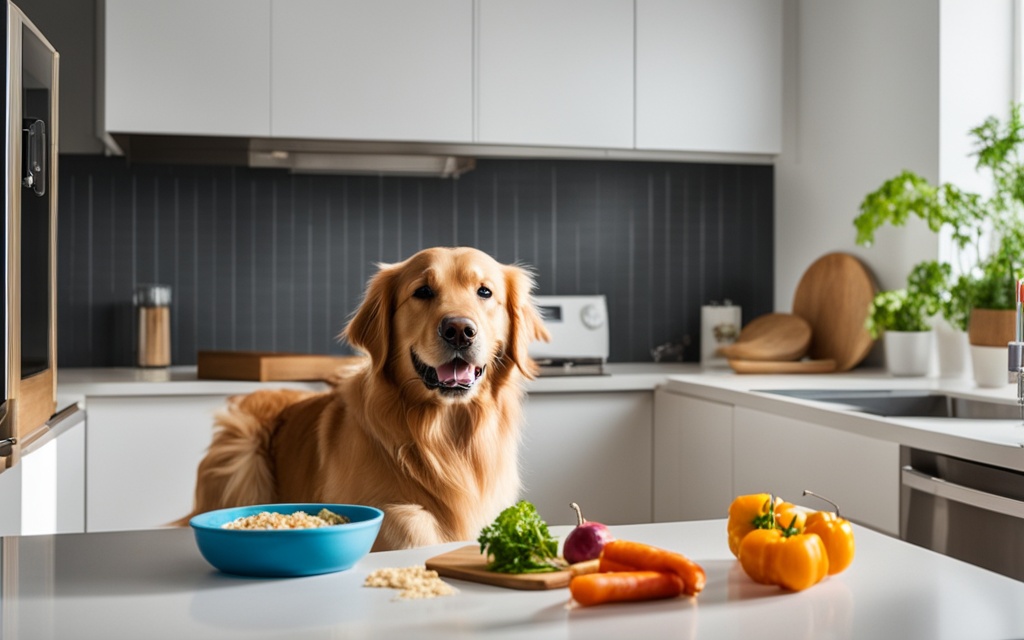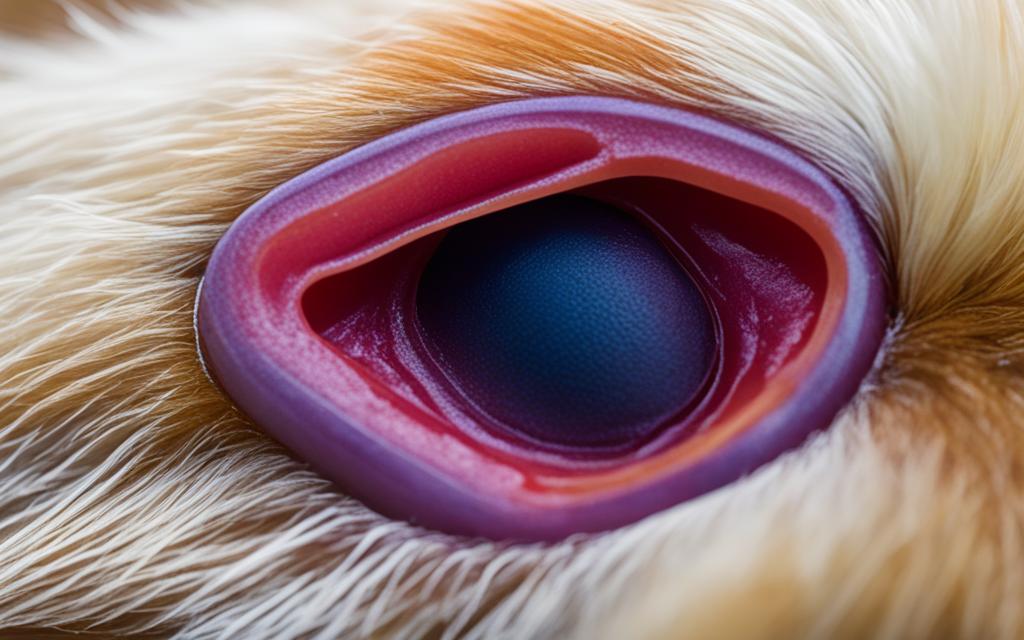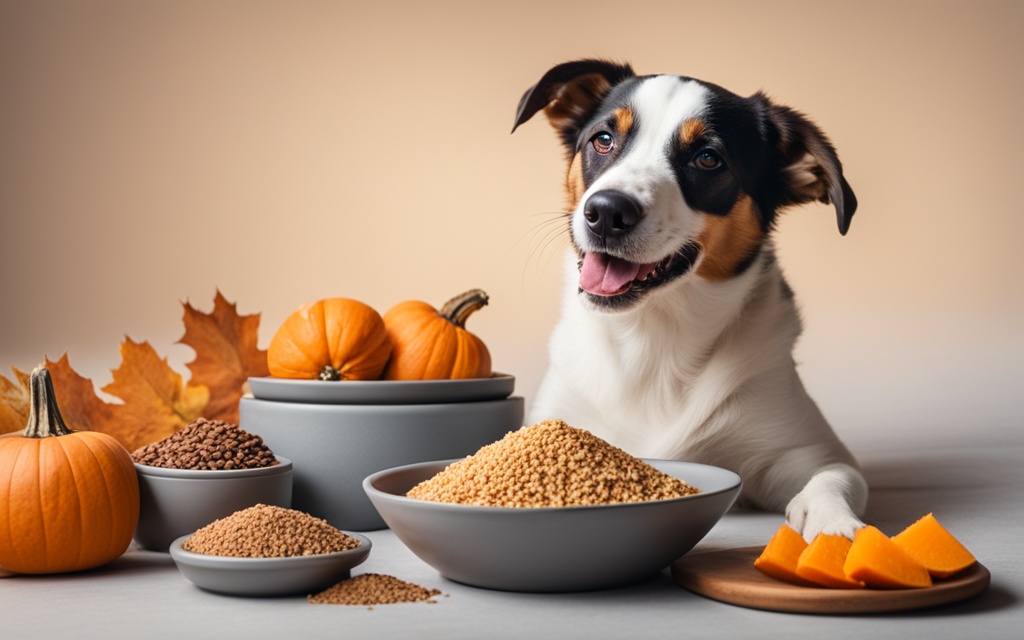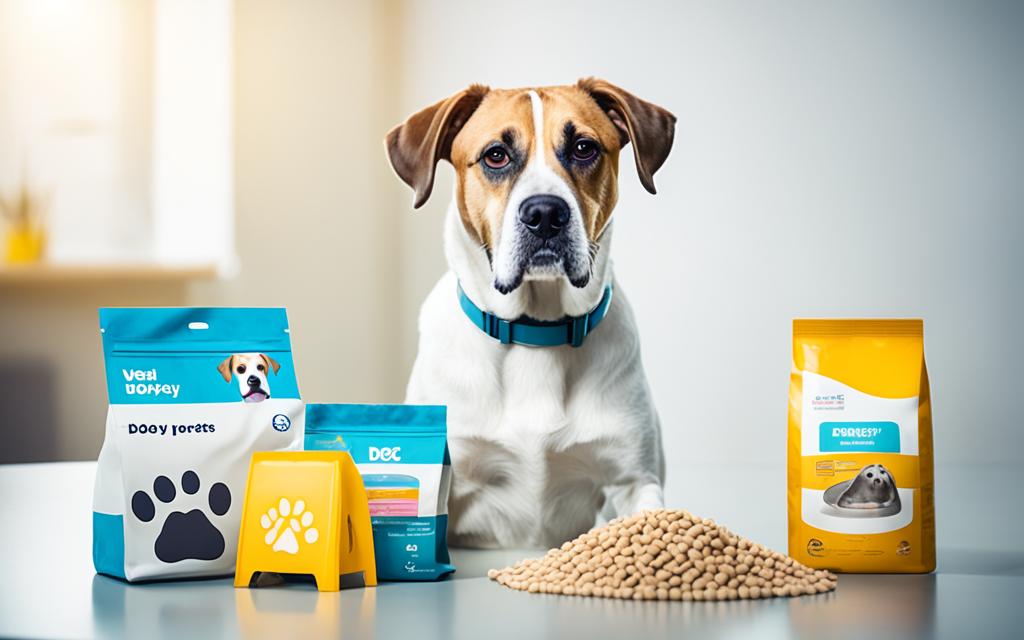Managing canine diabetes means taking a careful approach. It involves a good dog diabetes diet and complete care. This condition affects many dogs. Proper diabetic dog nutrition is key to keeping them healthy and happy.
Veterinary nutritionists stress the importance of special nutrition. They focus on how carbs affect diabetes in dogs. With the right diet, pet owners can help their dogs live better lives.
Understanding Canine Diabetes
Canine diabetes happens when a dog’s body doesn’t make enough insulin or can’t use it well. This makes blood sugar levels go up, called hyperglycemia. There are two main types: Type 1 and Type 2 diabetes.
Type 1 diabetes means the pancreas doesn’t make enough insulin. Type 2 diabetes means the body can’t use insulin well. It’s often linked to being overweight and hormonal issues. Knowing about these types helps spot risks early.
Many things can make dogs more likely to get diabetes. Being overweight is a big one, as it messes with insulin. Hormonal problems like Cushing’s disease also raise the risk. Plus, some breeds like Keeshonds, Poodles, and Dachshunds are more prone to it.
Studies show catching diabetes early is key to managing it in dogs. Spotting signs of diabetes before it starts can help prevent it. Owners should watch for changes in their dog’s behavior and talk to vets if they’re worried about their pet’s health.
| Type of Diabetes | Description | Common Causes |
|---|---|---|
| Type 1 | Insulin-dependent diabetes | Genetic factors, autoimmune issues |
| Type 2 | Insulin resistance | Obesity, hormonal imbalances |
Signs and Symptoms of Diabetes in Dogs
Spotting diabetes in dogs early can make a big difference in their life. Pet owners should watch for signs that show their dogs might have diabetes. These signs include:
- Excessive thirst (polydipsia)
- Frequent urination (polyuria)
- Increased appetite (polyphagia)
- Weight loss despite a good appetite
- Lethargy and decreased activity levels
Noticing these signs early is key to catching diabetes in dogs. Dogs with diabetes often drink a lot because they lose a lot of fluid. This can lead to dehydration if not caught.
Another sign is eating a lot but still losing weight. This happens because the body can’t use glucose well. Dogs may also seem tired because they don’t have enough energy.
For more info, check out vet resources on spotting these signs early. Catching diabetes early can lead to better treatment options for dogs.
| Symptom | Description |
|---|---|
| Polydipsia | Increased thirst, leading to excessive drinking. |
| Polyuria | Frequent urination, resulting in more trips outside. |
| Polyphagia | Increased appetite but continued weight loss. |
| Lethargy | Lower energy levels and reduced activity. |
Importance of a Balanced Diet for Diabetic Dogs
A balanced diet is key for dogs with diabetes. It helps keep blood sugar levels stable. Foods high in fiber and low on the glycemic index are great for this.
For diabetic dogs, it’s important to watch the fat and carb intake. A diet high in protein and fiber helps control insulin levels. This is crucial for dogs with diabetes. Many vets say the right diet can lower diabetes-related problems.

Studies show that a well-planned diet helps control blood sugar in dogs. Experts like the American Animal Hospital Association offer guidelines. These help pet owners know what foods are best for their diabetic dogs.
Here’s a table with key parts of a balanced diet for diabetic dogs:
| Component | Recommended Source | Dog Diabetes Diet Importance |
|---|---|---|
| Protein | Lean meats, fish | Supports muscle mass and healthy weight |
| Fiber | Vegetables, whole grains | Helps regulate blood sugar levels |
| Carbohydrates | Low glycemic index foods | Prevents rapid glucose spikes |
| Fats | Omega fatty acids | Promotes skin and coat health |
By following these guidelines, dogs with diabetes can live healthier, happier lives.
How to Manage Your Dog’s Diabetes Through Diet
Managing your dog’s diabetes diet means thinking about what and when they eat. Choose the right dog food that fits their dietary needs. Foods with lots of fiber and few simple sugars are good choices. Also, controlling how much and when you feed them is key to keeping their blood sugar stable.
Identifying Suitable Food Options
Look for these types of dog food:
- High fiber ingredients like brown rice, barley, and vegetables.
- Low-glycemic index grains for slow energy release.
- Proteins like chicken and fish for muscle health.
- Limited fat sources to prevent obesity.
Always check the labels for simple sugars and high-fat ingredients. Use dog food comparison charts or get advice from nutrition experts to make better choices.
Portion Control and Meal Timing
Controlling your dog’s diabetes diet is all about portion sizes and when you feed them. Here’s how:
- Measure food portions to avoid overfeeding.
- Keep a regular feeding schedule to manage blood sugar.
- Match meal times with insulin shots for best results.
Sticking to a routine helps your dog stay healthy and keeps their blood sugar steady.
| Food Type | Benefits | Examples |
|---|---|---|
| High Fiber | Helps regulate blood sugar | Brown rice, vegetables |
| Low-Glycemic Grains | Provides slow energy release | Barley, oats |
| Lean Proteins | Supports muscle maintenance | Chicken, fish |
| Moderate Fat | Prevents obesity | Fish oil, chicken fat |
Choosing the Right Commercial Dog Food
Choosing the right commercial dog food is key to your pet’s health. It’s important to understand what’s in the food you buy. A balanced diet helps keep your dog’s blood sugar levels in check, which is vital for diabetic dogs. Look at the nutritional value and ingredients to make the best choice.
Understanding Labels and Ingredients
When you read dog food labels, pay attention to the important parts. High-quality protein sources like chicken, turkey, or fish are good. Fiber is also key for healthy digestion and stable blood sugar. But, watch out for too many carbs. You want foods with low glycemic index ingredients. Here are the main things to think about:
- Protein content: Aim for 20-30% protein.
- Fiber content: Look for at least 5-10% fiber.
- Carbohydrates: Limit simple sugars and choose complex carbs like barley or brown rice.
Top Brands for Diabetic-Friendly Diets
Many brands offer dog food made just for diabetic dogs. These foods have the right balance of nutrients for your pet’s health. Here’s a table with some top brands for diabetic dogs:
| Brand Name | Key Features | Protein Source | Rating |
|---|---|---|---|
| Hill’s Science Diet | Veterinarian recommended, low fat | Chicken | 4.5/5 |
| Royal Canin | Preserves muscle mass, special diabetic formula | Chicken meal | 4.7/5 |
| Purina Pro Plan | Fortified with live probiotics, supports digestive health | Turkey | 4.6/5 |
| Merrick Grain-Free | High protein, grain-free formula | Beef | 4.5/5 |
Homemade Diet Plans for Diabetic Dogs
Making your dog’s food can help manage their diabetes better. It lets you tailor their diet to their needs. You need to know which foods help keep blood sugar stable and which ones can cause spikes.
Here are some key ingredients to use and avoid.
Ingredients to Include
- Lean meats such as chicken, turkey, or fish
- Vegetables like green beans, carrots, and spinach
- Whole grains such as brown rice and quinoa
- Healthy fats like fish oil or flaxseed oil
- Low-fat dairy in moderation
Ingredients to Avoid
- High-sugar fruits including bananas and grapes
- Processed carbohydrates such as white rice or bread
- Foods rich in sugars or simple carbohydrates
- High-fat meats that contain excessive saturated fat
Using special recipes for diabetic dogs can help make a meal plan for your pet. It’s important to talk to a vet or nutritionist before starting a homemade diet. This ensures your dog gets all the nutrients they need.
Incorporating Regular Exercise in Daily Routine
Exercise is key for dogs with diabetes, helping their bodies and minds. It keeps their blood sugar stable and their weight in check. This is vital for their health. Knowing how exercise helps can motivate owners to make it a part of their dog’s daily life.
When thinking about exercise for diabetic dogs, choose activities that fit your dog’s age, breed, and health. Here are some good options:
- Short, brisk walks: Perfect for most dogs, these walks help control blood sugar and keep their minds sharp.
- Interactive play: Games like fetch or tug-of-war can burn off energy and keep your dog fit.
- Agility training: Great for active breeds, these courses challenge their bodies and improve coordination.
- Swimming: A gentle exercise that’s good for older dogs or those with joint problems.
To make exercise a part of your dog’s life, try these tips:
- Make a daily exercise schedule to keep things consistent.
- Have playtime during the day to keep your dog engaged.
- Add walks to your morning and evening routines for structure.
Putting exercise first can make your diabetic dog healthier and happier. Regular activity is crucial for managing diabetes and strengthening the bond between you and your dog.
Monitoring Your Dog’s Blood Sugar Levels
Keeping an eye on your dog’s blood sugar is key to managing diabetes. Regular tests help owners track their pet’s health and catch problems early. Using a pet-friendly glucometer makes this easier.
Testing your dog’s glucose regularly is very important. Test at the same times every day, like before meals or when giving medicine. Keeping track of these tests helps spot trends and changes. This info can guide changes in diet or medicine.
Seeing patterns in your dog’s blood sugar levels can warn you of health issues. Things like what they eat, how much they exercise, and their daily routine can affect their levels. Never skip monitoring, as changes can cause big health problems.
There are guides to help you test your dog’s blood sugar at home. Getting to know the gear and how to use it makes testing easier. Monitoring your dog’s blood sugar is key to keeping them healthy and happy.
- Use a pet-specific glucometer for accurate readings.
- Test at the same times each day for consistency.
- Keep a log of all glucose readings for veterinary review.
- Be observant of changes in behavior or appetite, which could indicate fluctuations in blood sugar levels.
Effective blood sugar monitoring in dogs can greatly improve their diabetes care. This leads to a happier and healthier pet.
Regular Veterinary Check-ups and Their Importance
Regular vet visits are key for diabetic dogs. They help keep their health in check. Vets can watch blood glucose levels and adjust treatments as needed. These visits also help spot problems early.
During canine health check-ups, vets might run several tests, including:
- Blood tests to check glucose levels.
- Urine tests for glucose or ketones.
- Weight checks to keep your dog at a healthy weight.
Vets do more than just manage diabetes. They offer valuable advice for a full care plan for your dog. Working together with vets means quick action on any changes in your dog’s health. This leads to better diabetes care.

Conclusion
Managing dog diabetes means looking at diet, exercise, and health closely. Pet owners play a big role in their dog’s health by learning about diabetes care. It’s important to know what food is best for a dog with diabetes to keep their blood sugar stable.
Working closely with your vet is key. Regular vet visits help catch any health changes early. Learning more and using different resources can also help manage your dog’s diabetes and make them happier.
This article has given you tips to help your dog live healthier. Every little thing you do helps with diabetes management. Spend time learning, planning, and doing these things to make your dog’s life better.




